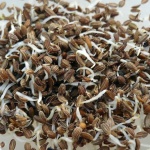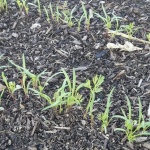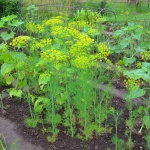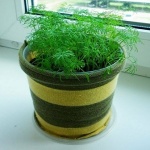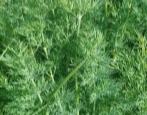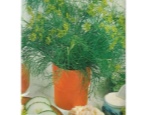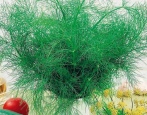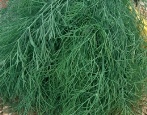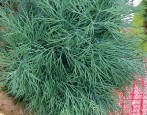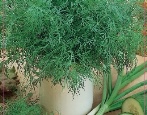
- Authors: Khomyakova E.M., Tsiunel M.M., Trebukhina K.A.
- Year of approval: 2002
- Leaf rosette: raised
- Socket height, cm: 30-40
- Ripening terms: mid-late
- The period from germination to biological ripeness (harvesting with spices): 110-115 days
- Foliage: strong
- Leaf size: large
- Leaf color: gray-green
- Dissection of leaves: strong
Dill is not only a well-known spice, it is widely used in the pharmaceutical industry. Its seeds contain essential oils, which are part of the mass of drugs. Therefore, varieties for industrial cultivation are very actively developed. The Alligator variety is a versatile variety suitable for any purpose.
Description of the variety
The alligator is a lush, highly aromatic variety that does not tend to actively stem. The bulk of the plant is delicate, fragrant foliage. Even if you cut the whole plant during harvesting, there will be few tough stems. The variety also stands out with a rosette. She is neat, presentable. The variety was included in the Russian State Register in 2002. Authors: Gavrish Company and Moscow Research Institute of Vegetable Breeding. The variety belongs to the late group varieties. Such varieties have a more lush rosette than early or mid-season varieties. From germination to stalking, such varieties take a very long time - not less than 65 days, which makes it possible to remove greens for a long time.
Characteristics of the appearance of the plant
The bush of the Alligator variety is very lush, up to 40 cm high, abundantly covered with airy leaves, the number of which can reach up to 20 per bush. The color of the foliage is gray-green.
During the flowering period, together with the peduncles, the plant reaches 160 cm. Umbrellas are formed relatively late, they are medium in size, dense - up to 50-56 rays.
Marketable shelf life is 3-6 weeks. This figure is considered to be medium-high for commercial varieties.
Purpose and taste
The variety is highly aromatic. Equally well suited for any purpose of use. The variety is eaten fresh. Umbrellas are used - as a seasoning for dishes or preservation. Lush greens are frozen in cut form for the winter or dried.
Ripening terms
Medium late variety, greens can be harvested 42-45 days after the emergence of mass shoots. Rosettes of seeds for seasoning are harvested after 110-115 days.
Yield
From 1 sq. m on average, 1.45-2.6 kg of marketable greens are harvested. The mass of greenery from 1 plant during harvesting is 15-20 grams, the mass with peduncles is 30-60 g. With high agricultural technology, up to 150 grams of marketable products can be obtained from 1 bush.
Growing regions
The variety is universal, grows well in any regions of Russia, from the North Caucasus to the Leningrad Region and the Far East.
Growing and care
The variety is equally well suited for a personal backyard and for growing for sale. The bushes are not too large, so you can grow Alligator dill on the balcony or windowsill. And also the variety is actively used in the conveyor belt growing of greens, since it is not prone to stalking and does not require repeated sowing.
Sowing is carried out at any time, from mid-April to mid-August.
Sowing density: 5-10 cm between plants, 20 cm between rows. Late-ripening varieties should not be thickened, bushes are long-playing, dense and they need more space than early ones.
Top dressing for dill Alligator is not needed, they are applied only at the stage of soil preparation. There are only a few things to consider when growing dill.
Germination of seeds. In all umbrella plants, the seeds contain a lot of essential oils. Therefore, they germinate for a long time, at least 20 days. It is better to additionally process the seeds before sowing.
Watering. Dill likes moderate but regular watering.
Several times during the growing season, the aisles are loosened and pulled out by weeds.
In extreme heat, the plants are equipped with shading screens so that their tips do not dry out.
To accelerate seed germination, you need to wash the essential oils from their shell. There are quite a few ways.
Soak in warm water with a little wood ash for 1 day. The water is changed every 4 hours.
Place the seeds in warm water for 4 hours, change every 20 minutes, then pour a very pink solution of potassium permanganate, rinse, dry.
Dilute the juice of aloe aged 2 weeks in the refrigerator with water in a ratio of 1 to 1. Soak the dill seeds in this solution for 1 day. Rinse, dry and sow immediately.
Sow seeds in the fall, in this case the dill rises 2 weeks faster.
Early spring sowing. Dill tolerates cold temperatures down to -3 ° С. It can be sown immediately before the snow melts completely. The melted spring water will gradually wash away the ethers, the dill will rise earlier. In this case, the first greens can be obtained even in April (depending on the region).
It is useful to water with salt. This protects the planting from bacterial diseases and pests. 1 tsp is added per 1 liter. salt, stir well. The mixture is poured into the soil every 4-6 days.
The crop is harvested as needed. All dill plants become most fragrant at the time of inflorescences. Greens can be cut off from the Alligator variety many times. There are different cleaning schemes.
Cut off the entire rosette when the plant reaches 20-25 cm. The growing point is left. After 2 weeks, a new crop is cut.
The plant is completely pulled out by the root when it reaches a height of 40 cm, or when it reaches biological ripeness (with foliage and an umbrella).
Gradually, every day, several leaves are removed from each plant.
If you need to greatly increase the yield, you can use foliar fertilizers. Once a week, dill is sprayed with a weak urea solution. 4 treatments are carried out. This technique increases the yield of marketable greens by 20%.
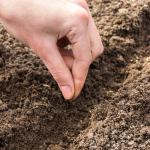
Dill cultivation is available in any conditions: open and closed ground, on a balcony or windowsill. Before planting dill, you need to carry out pre-sowing seed treatment, correctly determine the timing, prepare the beds.
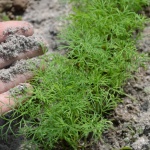
Soil requirements
Dill loves loose, well-drained, airy cultivated soil. It is better not to sow dill in areas where there has recently been a meadow or wasteland, there are a lot of weed seeds in such soils, and it is quite difficult to rid dense plantings of dill from weeds. Neutral acidity, pH 6.5-7.0. On acidic soils, plants germinate worse, slowly gaining green mass.
If the site has heavy, acidic, weedy soil, it is better to make separate beds for dill, on which suitable soil is poured.
During winter digging, organic matter, superphosphate, potassium chloride are introduced into the soil. When digging in spring - ammonium nitrate. Fertilizers with manganese and calcium are also applied on farms.
Review overview
The Alligator variety is very popular. This is a bright exemplary representative of the group of mid-late varieties. It is very popular with buyers, even those who took the seeds by accident. The bushes are, indeed, real "alligators". Very lush, green, aromatic even in poor growing conditions (in winter, in pots, with a lack of lighting). Does not hurt anything, the leaves are juicy, great taste. A small bed is enough for fresh consumption and remains frozen for the winter.
The variety also delights small farmers. The leaves are very large and look great in bunches. Even after cutting, the plant produces new young shoots. The yield is excellent, in the beds the plant looks very fluffy and rich. The Alligator variety is suitable for everyone, especially those who are looking for dill on abundant greens.
